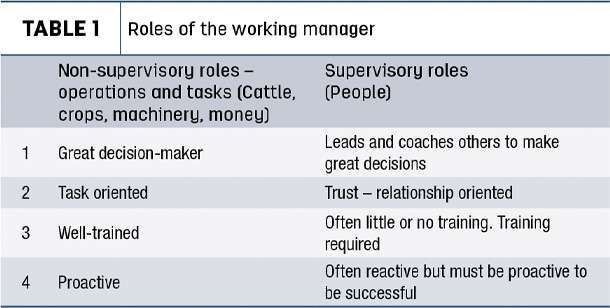Working manager is a challenging position because the two roles are very different, and that difference is rarely truly appreciated and accounted for.
Table 1 summarizes the key differences. The middle column describes the worker component of the position.

The last column describes what is needed to be an excellent team leader or supervisor. Each row is discussed below using the number in the first column to assist in identification.
1. Decision-making
Most employees are promoted to or hired as a supervisor or team leader because he or she was an exemplary worker – specifically he or she was a great decision-maker. It then seems logical to use that skill with the people he or she directs. The challenge is: When the leader makes the decision, the employee does not develop decision-making skills or confidence. The next time the employee has the same problem, he or she will likely once again come to the leader. The reality is: There are millions of working managers who are overworked and stressed because they are continually making decisions for those they lead.
The better alternative to making decisions for those they lead is to help them become better decision-makers. The dilemma is: Teaching the employee to make the decision takes more time initially, and working managers are busy with their own decisions and tasks.
To overcome this dilemma, the working manager must first understand that developing the employee will ultimately save time and improve performance. Success requires the working manager to have the personal discipline to make the supervisory role a priority and take the time to develop instead of deciding for the employee.
2. Position focus
In the operations and task portion of the position (middle column), the working manager is working with things – crops, livestock, facilities, finances, etc. Success here has typically resulted in the promotion to working manager with the now-new leading and supervising responsibilities. Working with people is very different – we humans can speak, think and feel. Here, the focus must be on developing the interpersonal relationship with the employee. With people, the leader is much more successful when the employee is involved and excited, even passionate about succeeding in their responsibilities. This requires building a trusting relationship. Skills and behaviors important here include active listening, being clear (“chalking the field”), quality feedback, support, encouragement and appreciation. The goal is for the employee to have the skill and the confidence to successfully execute their responsibilities.
3. Training
Almost always, the working manager was hired for their expertise, experience and potential in working with crops and livestock. Over time, their skills improved, and they were chosen to lead the team and supervise employees. In very few cases has this new working manager had training in leadership and supervision. Often making the situation more challenging is the reality that the promotion was based on success on the task functions, not on the individual’s potential as a leader and supervisor.
Would you hire an untrained person to work with your livestock or operate your planter, sprayer or combine without training? The answer is: of course not. I encourage your business to adopt a policy of providing supervisory training for every person hired into or promoted to a working manager position. Such training can be available locally via the internet or from my Success for Supervisors Program. This training should include the skills and behaviors mentioned above to develop a trusting relationship – active listening, being clear, quality feedback, support, encouragement and appreciation.
4. Proactive vs. reactive
Success with crops and livestock requires identifying potential and emerging issues and preventing or solving them quickly. We refer to this as being proactive. Working managers are typically excellent proactive problem-solvers. I strongly believe proactively identifying potential and emerging issues with those the working managers leads and supervises is at least as important as with livestock and crops. The emotional damage from failing to quickly address issues can reduce motivation, lead to disengaged employees and result in resignations. Unfortunately, working managers often are reactive in dealing with people problems.
I believe this reactivity has three roots: First, most working managers do not have the people skills to identify these problems before they emerge or fester. Second, they do not possess the skills to resolve the issues. Third, the people part of the working manager position is rarely given the priority it deserves. I believe that by making the people part a priority and being proactive, the people part will occupy less time in the long run and certainly be less stressful.
How to succeed as a working manager
As I said at the beginning of the article, the working manager position is very challenging. Nearly every working manager is more competent and comfortable working on the task side of the table. That makes it easy – and rational – to avoid the people side to the extent it is possible. It’s rational but not effective. To succeed, the working manager must change his or her approach to the position in two ways:
- Develop a plan to become more competent in leading and supervising employees. The plan can include formal training, informal training by paying attention to some of the myriad of people materials available online and by selecting a mentor.
- Make the people part a higher priority. I strongly believe this will enable greater success, both with people and with the task part of the position.

Bob Milligan is also professor emeritus, Dyson School of Applied Economics and Management, Cornell University.








